Volume Books in Nelson have a smartly curated range of children’s books that catch the eye. They chose five of their summer favourites to review for The Sapling. Witchfairy and One House for All are from Book Island, and we ran a sampling of these during January.
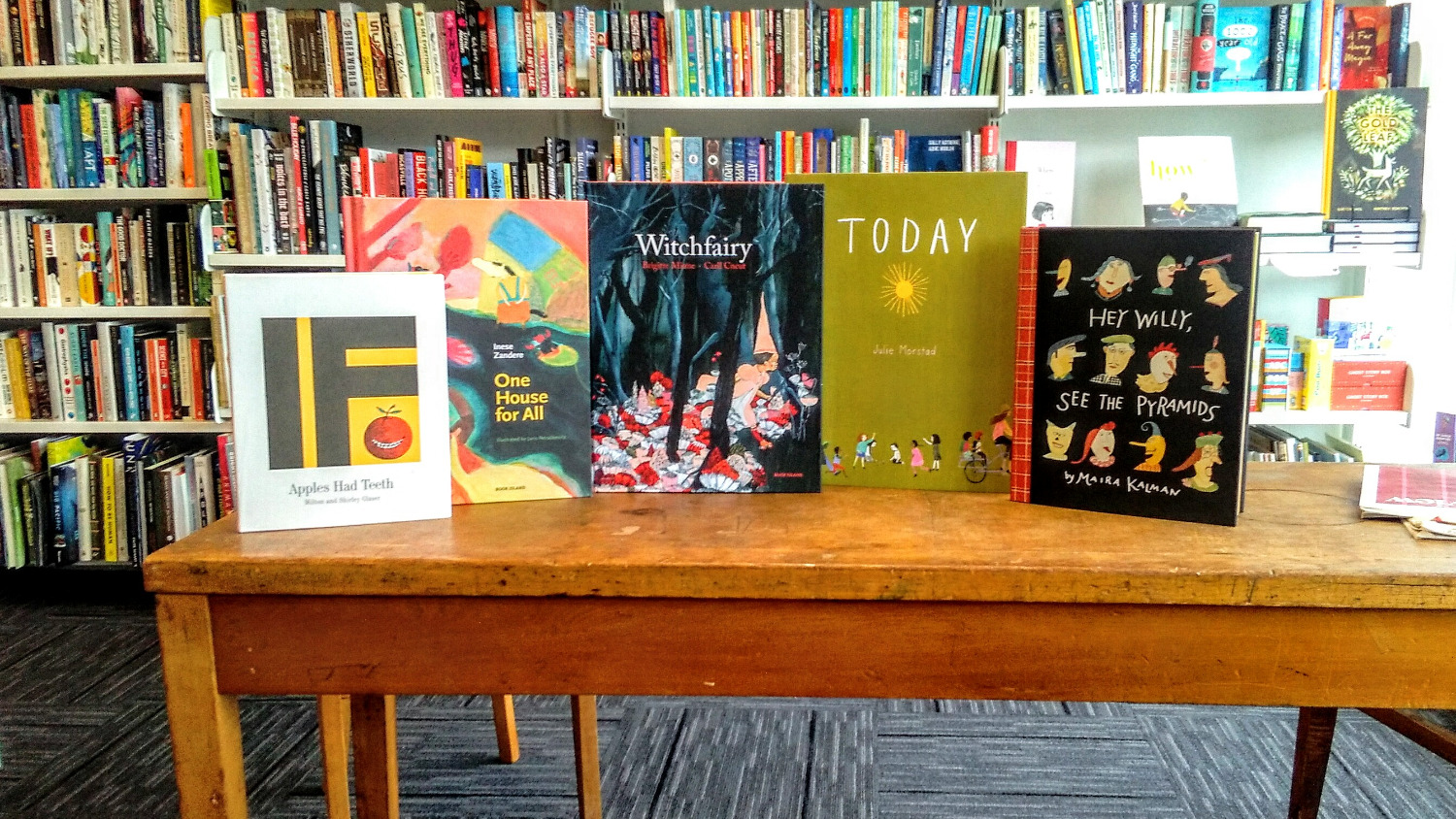
Witchfairy, by Brigitte Minne and Carl Cneut (Book Island)
When you want to fall into a picture and enter the world of a character without even reading a word, you know that you have been beguiled by some very luscious images. From the moment you pick up this book, you will be entranced. The cover and title invite you in, although with some caution as you contemplate the blue-black woods and the word ‘witch’. But there is also the word ‘fairy’ with its dream-like airy qualities and a rich floral carpet which a child, cherub-faced and determined, roller-skates through. She’s heading towards the edge of the book cover. Yet more temptation: follow her and open the book.
In the first paragraph we are introduced to Rosemary, a fairy, who has received a wand for her birthday, something all darling fairy children want, but not Rosemary, who is most put out. When you want roller-skates, a stupid magic wand is a disappointment. Her mother wants her to be like the other fairy children, who clutch their special toys, wands and handbags; who have the bows nicely tied in their hair, their pretty hats and frocks just so. They are sweet and have little tea-parties and tête-à-têtes. ‘They ate their cake without making crumbs. They drank tea without spilling a drop…They told only the sweetest stories with their honeyed voices.’
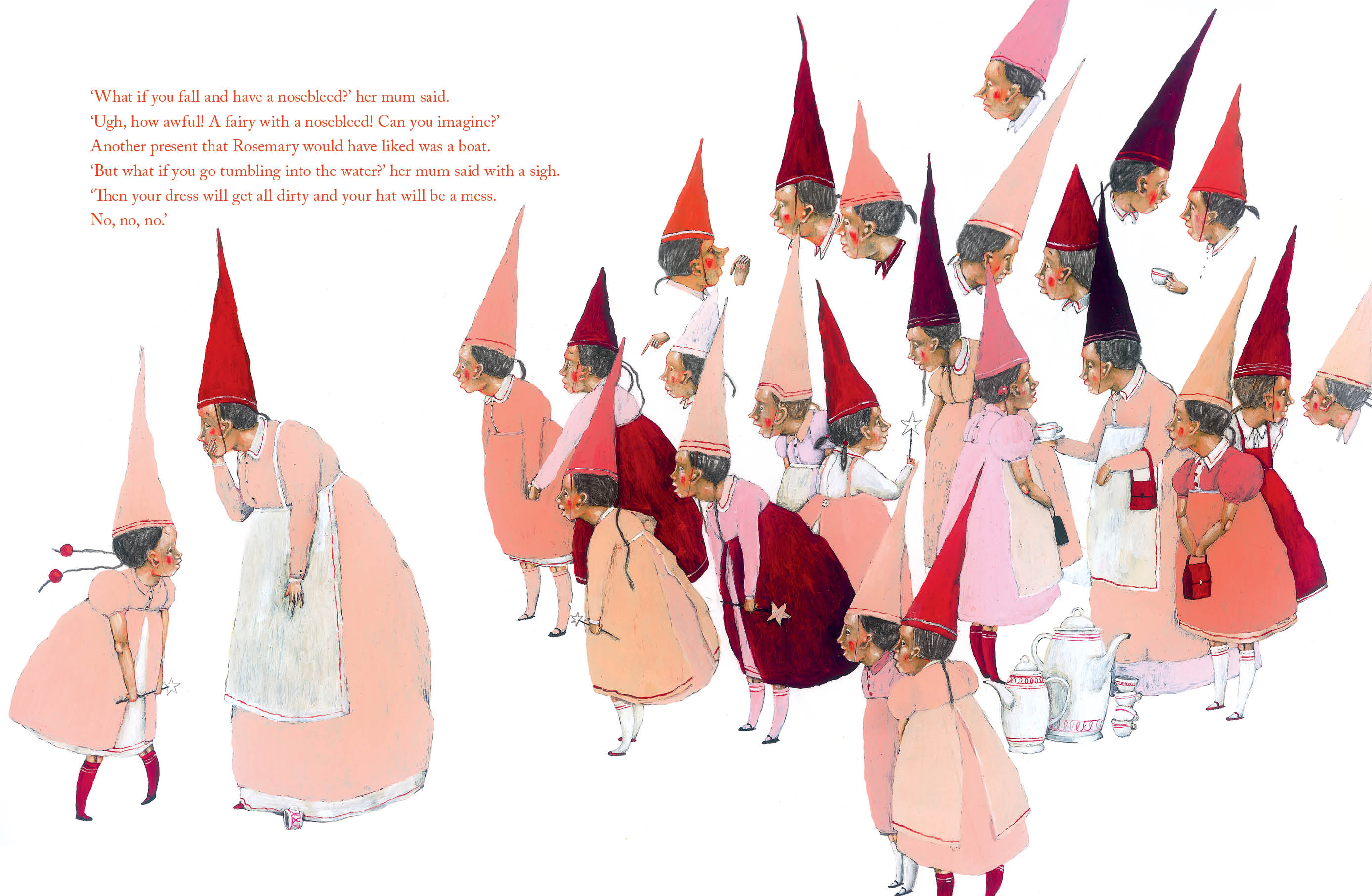
Rosemary’s mother says no to roller-skates, worried about falls and nosebleeds, and the disgrace of her daughter being a fairy whose hat might be askew or dress dirtied. Rosemary declares, much to her mother’s horror, ‘I want to be a witch’. And no one can persuade her to change her mind. Exasperated, her mother declares that witches cannot live in golden turrets – they live in the wood, so Rosemary packs her bags and flies away. Her mother knows she’ll be back soon.
The witch’s wood is gloriously dark compared with the pink, red and white pages of the fairy castles. Yet it is the perfect place for Rosemary. She builds a treehouse and a boat and forages for berries and nuts. She explores the forest, which has wonderful carpets of flowers, all in hues of red – a red which has become a signature colour for the illustrator and is commonly called ‘Cneut-red’.
She meets the witches, who are delightfully drawn with angled faces, grey hair and long pointed noses in contrast to the fairies who have rosy cheeks and small pert noses. We first see the witches poking their heads out of the river watching Rosemary. Are they dangerous? Author and illustrator make us wait a few pages to find out the true nature of the witches. They are kind and generous, reminiscent of kindly aunts and grandmothers, welcoming and encouraging Rosemary. They give her roller-skates and teach her how to ride a broom. Life in the woods is good and Rosemary is having a ball.
Minne uses words deftly. You can almost hear Rosemary stamp her foot in defiance, though this is never described. You can feel Rosemary’s wistful wantings even though these are not explicitly said. Minne’s skill as a writer, combined with Cneut’s illustrations, his ability to render facial emotions and to use colour, the warm reds and the cold blue-blacks to intensify those emotions and the tension inherent between Rosemary’s two worlds, will make Witchfairy a new favourite for many.
Minne uses words deftly. You can almost hear Rosemary stamp her foot in defiance, though this is never described.
Yet is the content that takes it that next layer deeper. Witchfairy tells the story of a girl who feels out of place, who doesn’t want to be what she was born to. The world of golden turrets isn’t for her – she wants to run and chase the wind, to get grubby and play a few tricks. Being a witch is a fine thing, but Rosemary wistfully looks up at the moon and wonders about her other life. And Rosemary’s mother misses her so much, she decides to visit her. They find out together who Rosemary is: neither fairy nor witch but a combination of both, a witchfairy.
This is a charming adventure about a curious young child and her desire to be herself, as well as a mother’s acceptance and love of her child in whatever guise that takes. (SC)
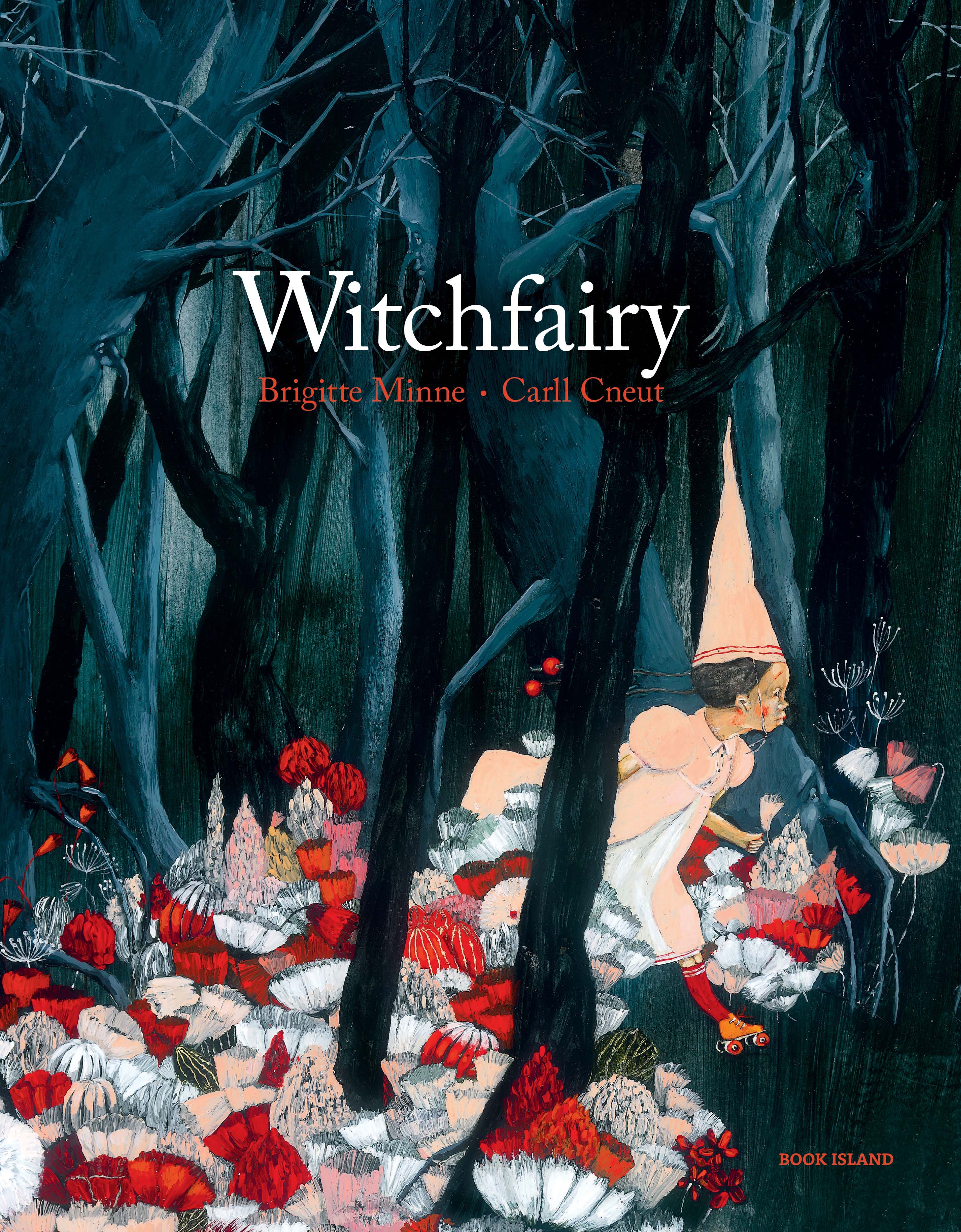
Witchfairy
By Brigitte Minne
Illustrated by Carll Cneut
Book Island
RRP: $30.00
Watch an interview with Carll Cneut
One House for All, by Inese Zandere and Juris Petraškevičs (Book Island)
Juris Petraškevičs’ arresting gauche acrylic paintings sit delightfully on the pages of fellow Latvian Inese Zandere’s One House for All. They immediately draw your attention with their bright colours and zany energy enhancing this simple story about three friends and a problem they have.
Horse, Raven and Crayfish are friends. They have enjoyed each other’s company throughout their youth, but now are ready for the next adventure in life. They want to settle down, get married and have families. Sitting beside the river, they consider the perfect house – a place where they can all live. Each friend takes his turn in describing what they should build. For Horse, there has to be a meadow. ‘It should have a large, green living room with juicy grass.’ Raven designs a house high in a tree. And Crayfish, underwater: ‘a wide door leading down to a long passage three claw spans under the water.’ Alas, none of the houses suit all of the friends. Maybe they shouldn’t marry at all! Just as they are despairing, contemplating giving up either their futures or their friendship, Crayfish comes up with a solution that pleases everyone.
The illustrations make this book sing. They are wonderfully naive and the colours are vibrant creating a luscious forest backdrop, trees hot orange and verdant green, flowers friendly triffid-like creations, and a rich blue river teeming with life.
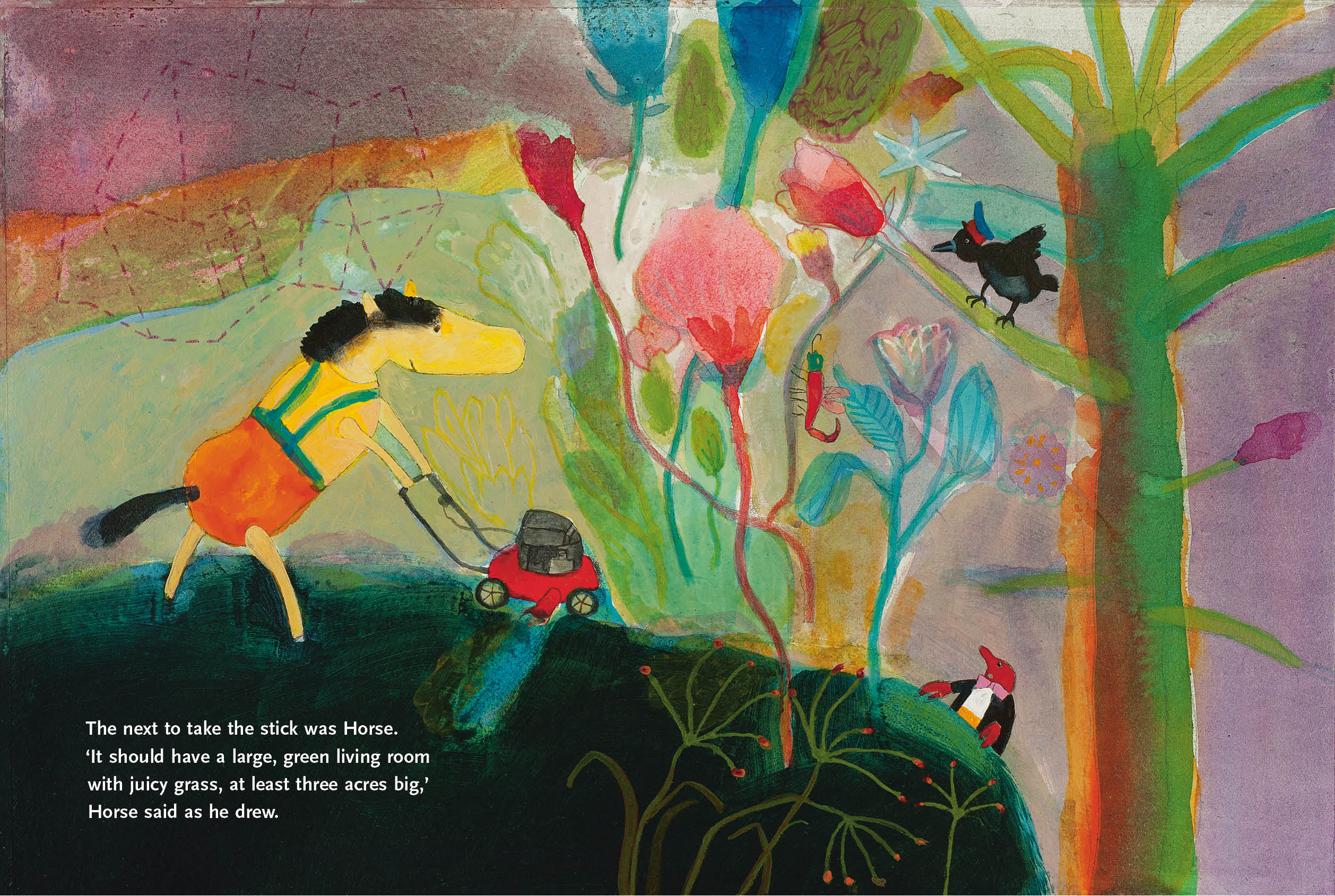
The friends are all charming – Horse standing up on his hind legs – gentle and innocent; Crayfish rather dapper in his suit jacket and bowtie; and Raven with his perky cap. There is plenty of humour in the pictures as they play out each character’s imagination and thinking. Horse, imagining his grassy living room, mows the lawn. Raven’s house high in the branches of the trees has a chimney with smoke gently wafting from it. Fish swim by and fireflies flitter across the pages.
One House for All is a simple story with a big heart, a story about friendship. Despite their differences, Horse, Raven and Crayfish are determined to remain close, even when their needs and desires vary greatly. It’s a tale of how co-operation, compromise and consideration can help us live together harmoniously. ’And in the evenings, they all sat together by the river, swinging their legs: two legs if they were ravens, four legs if they were horses, and lots of legs if they were crayfish.’ (SC)
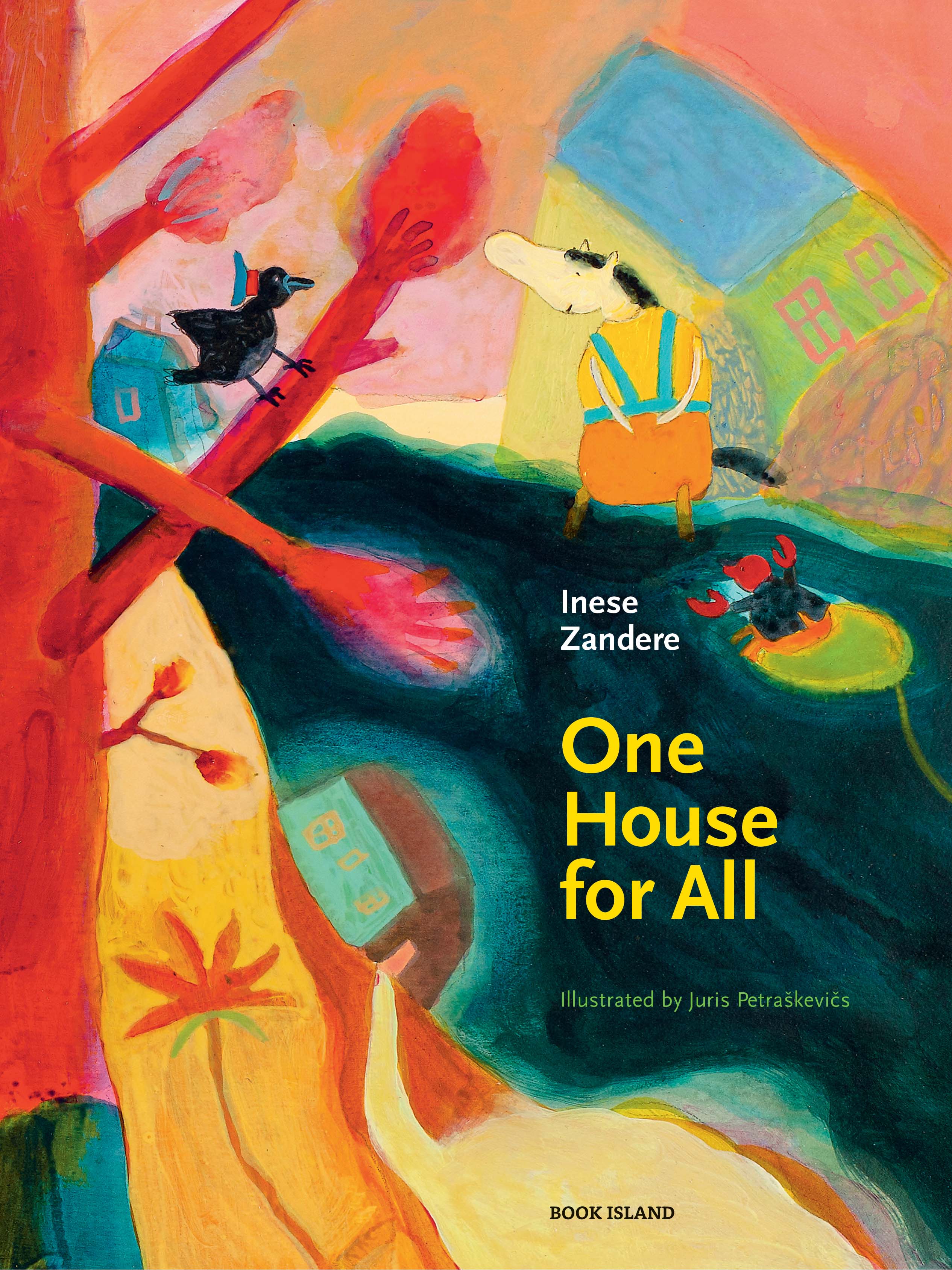
Today, by Julie Morstad (Simply Read Books)
Every day is full of possibilities. It’s the simple things that make each moment precious and enjoyable. From getting up to going back to bed, Julie Morstad takes us on a journey through a day filled with joy, inquisitiveness and, best of all: choices! Open the book and begin.
‘What should I do today? But first, what’ll I wear?’ Turn the page to find a double spread of clothes. Warm socks or no socks? A cloak or a crown? Or both? A party dress or a ninja mask? And a page devoted to how to wear your hair today. Dreadlocks, bangs, just a little messy or neat and tidy? Thankfully this isn’t a book about how to look, it is much more fun. The book suggests great things to do and where to do them: it could be your own backyard, a museum, a skate-park or perhaps a tiny island just for you. And how do you get there? By bike, bus or follow-the-leader?
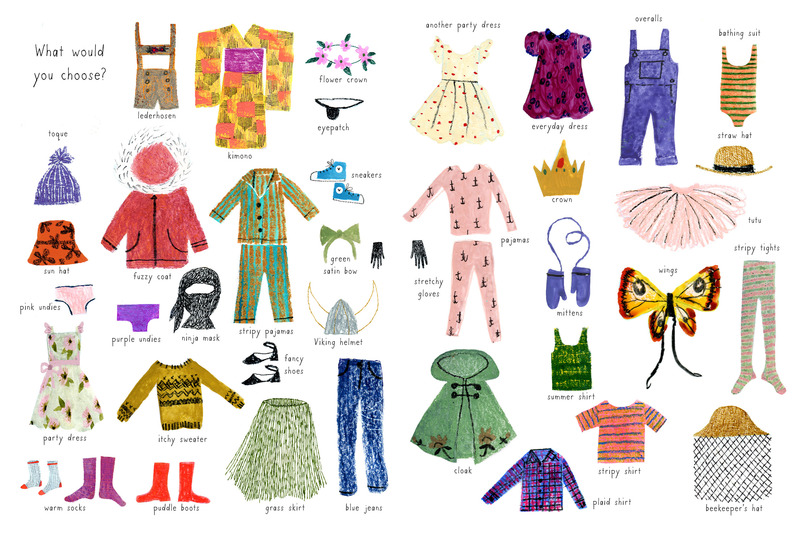
The suggestions range from the ordinary to the whimsical, from noisy run-about activity under gushing water sprinklers to quiet introspection lost among the flowers. You could look at art at the gallery, ‘looking at the most beautiful thing you’ve ever seen,’ or create your own music by starting a band. There are activities to do alone and fun to have with friends. And, of course, there is reading a favourite book! And this child’s book lets the reader choose a favourite animal. Hot sunny days need a page of icy treats: the watermelon on a stick looks tempting. Stormy weather brings dolls, drawing, and maybe a tea party.
Today allows a child to decide what a day will bring, to make choices and enjoy the process of deciding. While many pages make suggestions to the reader, many others offer options or stop and ask the reader a question, engaging the child and making their world part of Today. ‘Here are some things in my room. Do you have some of these too?’ Lucky string, wooden dolls, missing dominoes, best marbles and special marbles.
Today allows a child to decide what a day will bring, to make choices and enjoy the process of deciding.
Award-winning independent Canadian children’s press Simply Read Books, has done a wonderful job on production. Morstad’s captivating drawings are reminiscent of Ezra Jack Keats and early Maurice Sendak illustrations. There are hints of Scandinavian influence and a nod to some contemporary Japanese illustrators. Morstad illustrates her own books, as well as those of others and her style is very appealing.
The text is playful and involving. She gives enough to entice the reader, yet holds back from swamping the pages with extraneous language which would interfere with the spirit of exploration that makes Today so charming. We can all relate to the need to stop and notice the wonder in every day, both in the ordinary and the special. With a little imagination and a delightful book, today will be a good day.
Now, what shall we have for breakfast? Eggs and soldiers, berries, porridge or a smoothie? (SC)
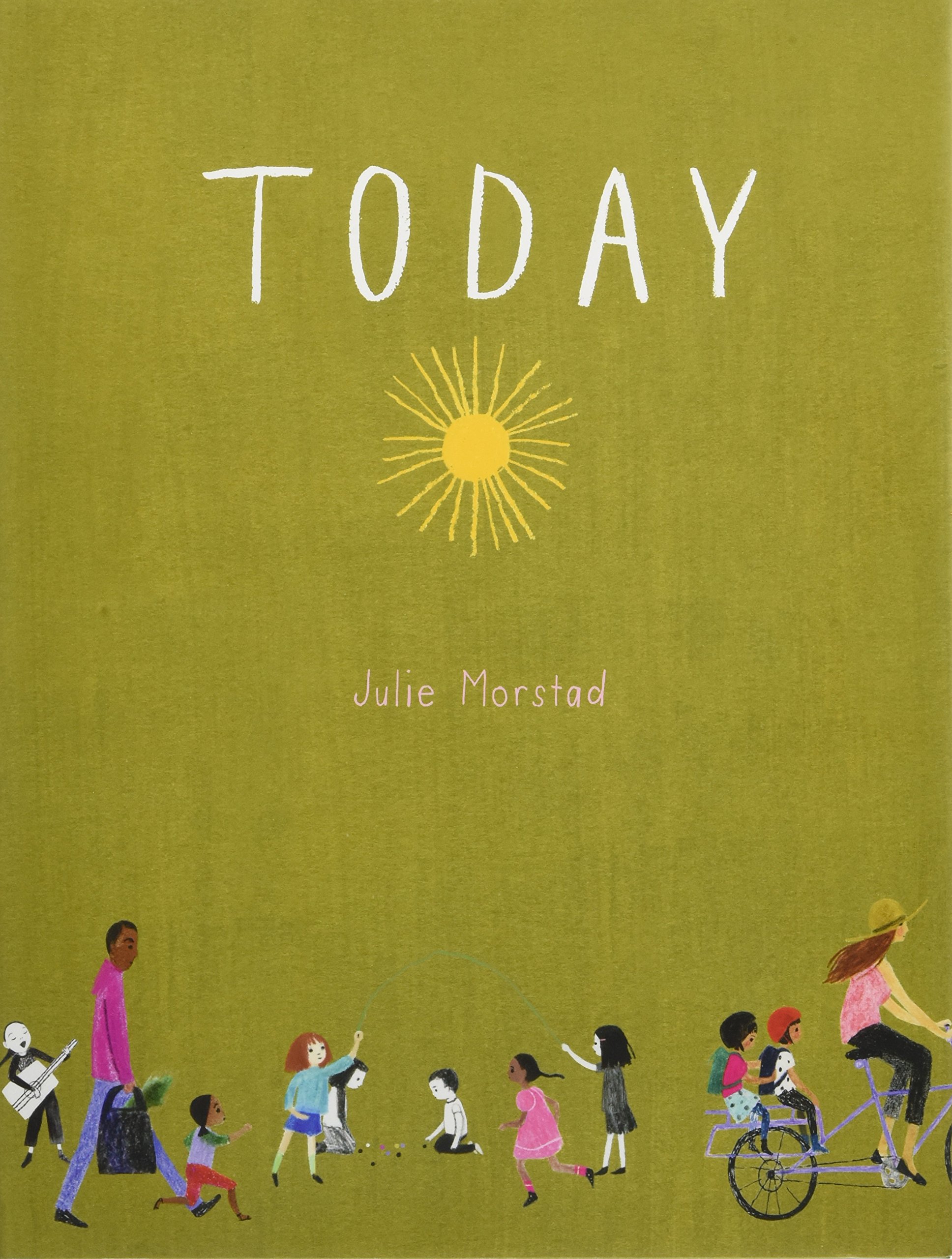
If Apples Had Teeth, by Milton and Shirley Glaser (Enchanted Lion Books)
If apples had teeth, they would bite back. If trees were pink, they would be nevergreens. This silly, inventive picture book illustrated by the outstanding graphic designer of the protopsychedelic era will make your brain turn somersaults. Each page presents a counterfactual situation, encouraging children to speculate about their world in a playful way.
Art, poetry and meaning are all profitably generated from nonsense, and a creative life can be achieved by learning to look at the familiar in fresh ways.
A facsimile of the original 1960 edition, the book is exquisitely produced and printed (on just the right paper stock!), and is the perfect addition to the shelf of either an imaginative child or anyone interested in period design. Sometimes the counterfactual is counter-counterfactual (how liberating!): If a zebra wore striped pajamas, you would never know. (TK)
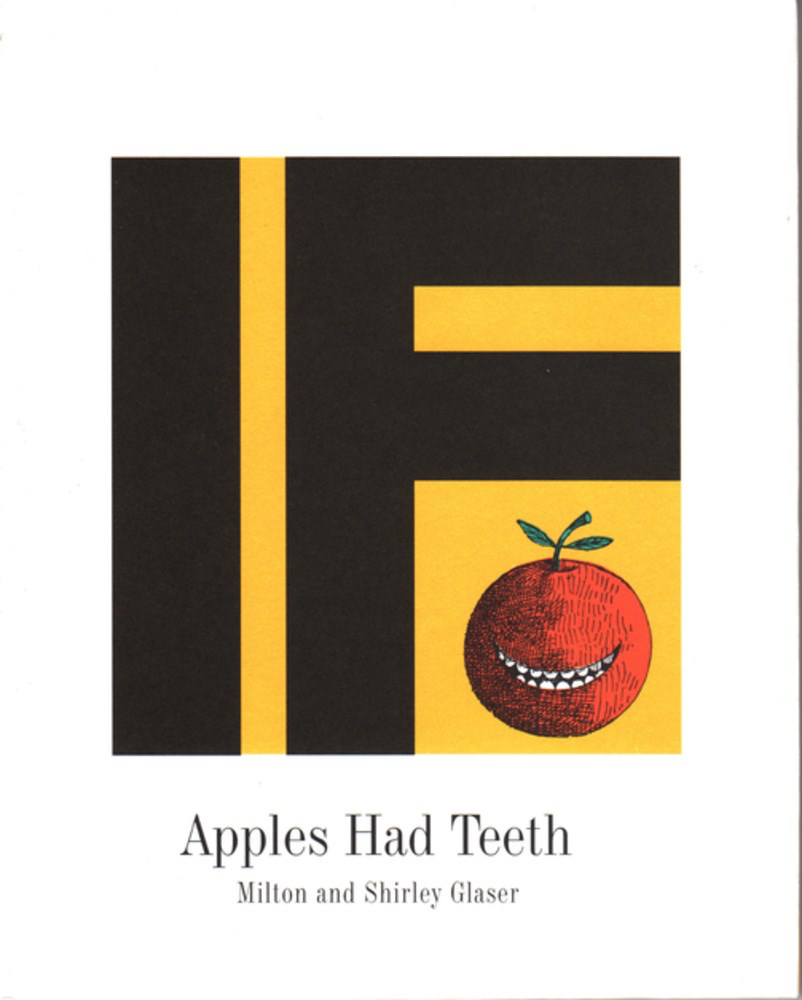
If Apples had Teeth
By Milton and Shirley Glaser
Published by Enchanted Lion Books
RRP: $30.00
Hey Willy, See the Pyramids!, by Maira Kalman (New York Review of Books)
Sometimes, in the middle of the night, when it is dark, I call to my sister: “Lulu, Lulu, Lulu. Wake up. I can’t sleep. Tell me stories.” “Oh, no,” says Lulu from far away. “Not again,” and shuffles over to my bed. What kinds of stories do two sleepy children share in the middle of the night? The stories here are quite possibly ones actually told by Kalman’s actual daughter Lulu to Kalman’s actual son Alexander, but their actuality or otherwise is unimportant: these are stories exemplifying the playful access to the unconscious (or the access to the playful unconscious) through the nonsense, exaggeration and humour common to children and some adults – including, presumably, Maira Kalman.
. . . these are stories exemplifying the playful access to the unconscious (or the access to the playful unconscious) . . .
Details from the children’s lives are given all-consuming prominence, or are developed along lines untempered by practicality or many of the other strictures of reality. The family’s neighbour brings flowers to a party but forgets his trousers, their aunt’s and uncle’s dog wants to run away to Paris and become a poet, a woman has very small ears but she hears everything. Much happens, but little of consequence, which is probably appropriate for midnight stories.
Kalman’s illustrations are, of course, the great attraction of the book (and are inseparable from the stories): quirky, colourful, something like Marc Chagall on acid, full of details that almost require further stories of their own. It is this provision for further story, this liberation from the strictures of systems and logic, this acknowledgement of the nature and tendencies of the child mind that persists even in creative adults, that makes this a book that will inspire and reward repeated readings. (TK)
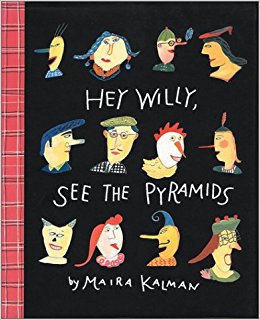
Hey Willy, See The Pyramids
By Maira Kalman
Published by The New York Review of Books
RRP: $32.00
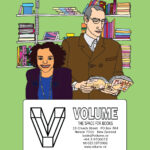
Stella Chrysostomou and Thomas Koed
Stella Chrysostomou and Thomas Koed have between them over 35 years’ experience in the book trade. In late 2016, they opened VOLUME, a small independent bookshop selling interesting fiction, incisive non-fiction and wonderful children’s books in Nelson’s Church Street Bohemian Quarter. They offer weekly newsletters of their reviews, and a monthly reading subscription service. Image by Karolina Jortan.



